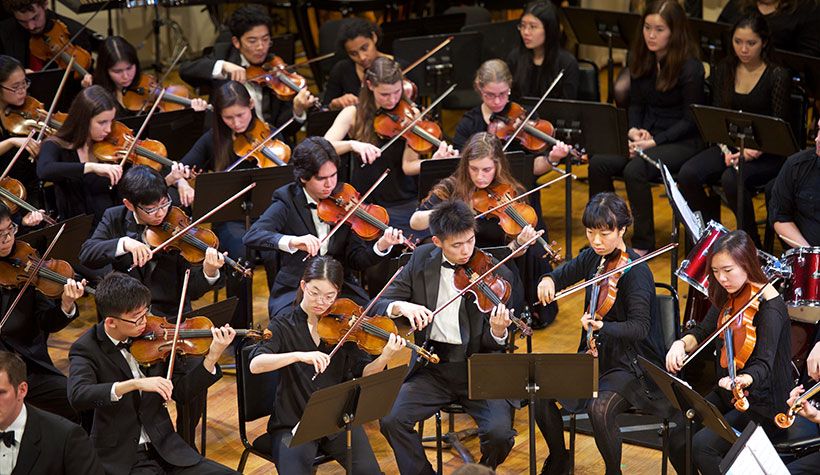Despite Complications, Orchestra Wows with Stravinsky

On Saturday, March 7 at 8 p.m. in Buckley Recital Hall, the Amherst Symphony Orchestra performed Igor Stravinsky’s “Pulcinella Suite” and “Petrushka” ballet for its Russian Masters concert series in the 2019-2020 season.
Stravinsky’s neoclassical style with “bold blocks of sound” — as composer Dave Kopplin described it in the program notes for the L.A. Philharmonic — offers a fresh and unique listening experience within a ballet storyline. Unfortunately, though immediate members of the college community were able to attend, campus-wide restrictions on large gatherings in response to concerns over COVID-19 closed the concert to members of the public.
The orchestra opened its program with “Pulcinella,” a ballet commissioned by impresario Sergei Diaghilev in 1919 which premiered in Paris the next year. In his day, Stravinsky composed in an innovative response to his contemporary 18th-century bass lines, adding original harmonies and rhythms until it became entirely his own.
While “Pulcinella” was initially criticized for “offending the classics,” “deserting modernism” and “renouncing of true Russian heritage” (according to the program notes by Phillip Huscher for the Chicago Symphony Orchestra), its premiere was actually a great success, with artistic choreography by Leonide Massine and costume and set design by Pablo Picasso.
As for the student performance — not quite. Much to the chagrin of both orchestra and audience members, the conductor stopped and restarted the performance of “Pulcinella” during the second movement, explaining to the audience that because of the original oboist’s sick absence, the piece was essentially still a work in progress. Despite this, the musicians were largely in agreement that “Pulcinella” was a great deal simpler to perform than “Petrushka,” which was written in 1911 with themes reflecting the memories of violence and unrest during the Russian Revolution of 1905.
“Petrushka” tells the story of a puppet whose character is iconically rude, cunning, high-pitched and annoying. His role as offensive provocateur fits perfectly with Stravinsky’s original vision of the composition, as he said in his autobiography: “I had in my mind a distinct picture of a puppet, suddenly endowed with life, exasperating the patience of the orchestra with diabolical cascades of arpeggios.”
The orchestra wholeheartedly agreed. “It’s the hardest and most hard-to-understand piece yet,” said violinist Isabelle Kim ’23, remarking that it felt completely different from the works of Stravinsky’s contemporaries. “I think it does feel sort of similar to Rimsky-Korsakov though, maybe in the … messiness of them both.”
This is a rather fitting description of Stravinsky’s works, as he had studied under Rimsky-Korsakov and borrowed many of his teacher’s stylistic choices in his own compositions. “Petrushka” features brash, noisy elements that capture the squabbling vendors’ cry, stumbling drunkards, laughing children and parade-goers in the streets during the Shrovetide Fair in St. Petersburg, Russia. The flute solo of repeated perfect-fourth intervals amidst a cacophony of sixteenth-note motifs in the very beginning of the piece especially alludes to this imagery.
To further emphasize the trickster character of the puppet Petrushka, Stravinsky made intentional stylistic dissonances by putting certain parts of the piece in two different keys, effectively confusing the listener and making it difficult to understand the music. Indeed, Stravinsky’s legacy is that of stylistic diversity and revolutionary rhythmic structure that challenged the boundaries of conventional classical music.
In her Stravinsky lecture on March 4 at Webster Hall in New York, one of the many pre-concert talks that took place this year, Professor of Music Klara Moricz described “Petrushka” as an attempt to “probe its time during the early 20th century, a paradoxically important movement for Russian culture during which artists attempted to define the past as well as the present in conversation with the past.” The production was a form of urban art, with Stravinsky’s revolutionary musical style paired with the grotesque, difficult character of Petrushka; the attendees of the lecture, when asked what word they first thought of upon listening to the bars of the murder scene in “Petrushka,” responded: “Manic, energetic, agitated, mechanical, sudden, violent and sad.”
This is consistent with the earlier criticisms of “Petrushka” because of its original inspiration — traditional folk music. Contemptuously thought to be simple, dirty, lower-class, cheap and unsophisticated because of this, “Petrushka” fully embodies all of its associations in both musical sense and in the personality of its main character.
In fact, the origins of Petrushka perfectly fit with Stravinsky’s daydream during its composition: “I saw a man in evening dress with long hair, poet of romantic tradition, hammering incongruous objects in the keyboard while the orchestra burst out in vehement opposition,” we wrote.
When performed with the full ballet production, the more mechanical, “cold” music achieved by strict rhythms and pitches are given to actual humans in scenes with crowds of people, while the more “magical” music — irregular rhythms, non-diatonic pitches — are given to the puppets, reflecting the irony of blurred lines between reality and art.
The consensus of the Amherst Symphony Orchestra was that this particular production was by far the most difficult in the year-long Russian Masters series, in part because of the complexity and irregularity of rhythm and in part because of Stravinsky’s perplexing creativity and character. The orchestra was brought to a stop a second time during the last few pages of Petrushka, after the conductor perceived that the ensemble was not playing together in rhythm.
There was a surprisingly large turnout even with only Amherst College students and faculty in the audience, after the college prohibited non-Amherst affiliated individuals from attending events on campus.
Even with the program’s hiccups, it was a successful run for the most part and a reasonable tribute to Igor Stravinsky — one of the greatest Russian composers of all time.





Comments ()